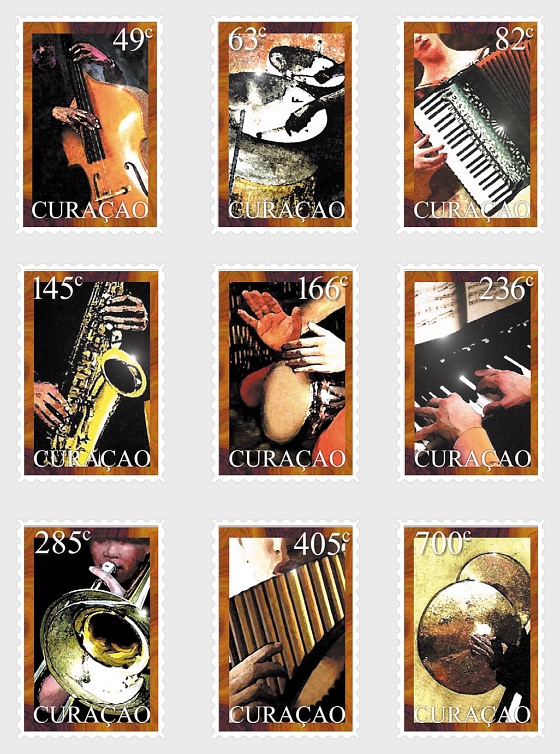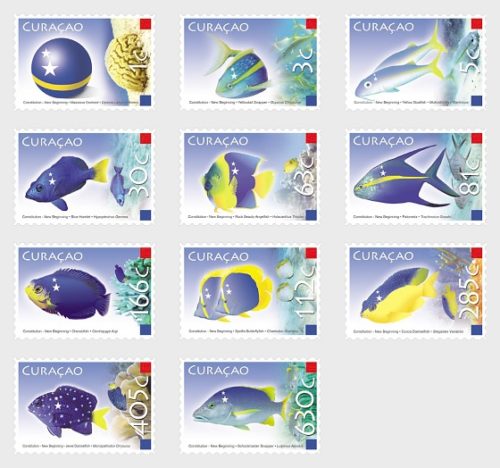Description
49 cents stamp: Contrabass
The name contrabass refers to the lowest voiced instrument in a family. It is used in naming instruments in the woodwind, brass, percussion, and string families, sometimes with instruments that are named from the same schema (soprano, alto, tenor, bass), but not always.The contrabass varies in size, shape, and number of strings.The contrabass is an orchestral instrument in the same family with the violin, viola, and violoncello or cello. In the orchestra it often contributes to harmony, but there are also solo parts written for it.
63 cents stamp: Steelpans or pans
Steelpans also known as steel drums and sometimes, collectively with musicians, as a steel band is a musical instrument originating from Trinidad and Tobago. The pan is a chromatically pitched percussion instrument made from 55 gallon drums that usually store oil. In fact, drum refers to the steel drum containers from which the pans are made; the pan is struck by a pair of straight sticks tipped with rubber; the size and type of rubber tip is unique to the class of pan being played. Some musicians use four pansticks, holding two in each hand. Steel pan musicians are called pannists
82 cents stamp: Accordeon (Accordion)
An accordion is a type of hand held musical instrument. Because of the characteristic way in which an accordion is operated, the instrument is sometimes known as a squeezebox. Accordions have been made since the 1700s in Europe, and appear in the folk music of several European nations. A person who plays the accordion is called an accordionist. The instrument is sometimes considered a one-man-band as it needs no accompanying instrument. The performer normally plays the melody on buttons or keys on the right-hand manual, and the accompaniment, consisting of bass and pre-set chord buttons, on the left-hand manual.
145 cents stamp Saxophone
The Saxophone also referred to as the sax is a family of instruments that belongs to the single reed group of woodwinds, which also includes clarinets. Saxophones are made of metal, often brass. Despite this, they are considered a woodwind rather than a brass instrument. The saxophone is most commonly associated with popular music, big band music, blues, early rock and roll, ska and particularly jazz. The saxophone was invented by the Belgian clarinetist Adolphe Sax in 1846. He wanted to create an instrument that would both be the most powerful and vocal of the woodwinds and the most adaptive of the brass, which would fill the then vacant middle ground between the two sections.
166 cents stamp Djembé.
The Djembé drum – also known as jenbe or jembe, is a West African percussion instrument that is gaining popularity. The Djembe is a single skin African drum that resembles a chalice in shape. Some people have likened its appearance to a mushroom. It is designed to be played with the hand. A key point about the djembe is that the base as well as the “cup” is hollow. This produces additional resonance and helps give the drum its distinctive sound and variety of percussive sounds. The drum is traditionally carved from one piece of wood and covered with goatskin. According to the Bamana people in Mali, the name of the Djembé comes directly from the saying “Anke djé, anke bé” which translates to “everyone gather together in peace” and defines the drum’s purpose.
236 cents stamp Piano
The word Piano is a shortened form of Pianoforte, the Italian word for the instrument. The Piano is a musical instrument played by means of a keyboard. It is one of the most popular instruments in the world. Widely used in classical music for solo performances, ensembles use, chamber music and accompaniment. Although not portable and often expensive, the piano’s versatility and ubiquity have made it one of the world’s most familiar musical instruments. The musical terms “piano” and “forte” mean “quiet” and “loud,” and in this context refers to the variations in volume of sound the instrument produces in response to a pianist’s touch on the keys.
285 cents Trombone
The Trombones, along with trumpets, horns, and tubas, make up the main groups of the brass instrument family. The name “Trombone” means large trumpet, and that is how they were conceived. The individual trombones that make up the group include the slide trombones, soprano trombone, the alto, tenor, bass, and contrabass trombones, and the valve trombone, which features valves in place of a slide. Of these, the alto, tenor, and bass trombone are used in the contemporary orchestra, with the tenor being the most often used in jazz.
405 cent Panflute or Panpipes
The Panflute or panpipes is an ancient musical instrument based on the principle of the closed tube, consisting usually of five or more pipes of gradually increasing length (and, at times, girth). The pan flute has long been popular as a folk instrument, and is considered the first mouth organ, ancestor of both the pipe organ and the harmonica. The pan flute is named for its association with the rustic Greek god Pan. The pipes of the pan flute are typically made from bamboo or giant cane; other materials used include wood, plastic, and metal. The pan flute is an air-reed instrument. Its sound is produced by the vibration of an air-stream blowing across an open hole at the end of a resonating tube.
700 cent Cymbal
Cymbals are a common percussion instrument. Cymbals consist of thin, normally round plates of various alloys; the greater majority of cymbals are of indefinite pitch, although small disc-shaped cymbals based on ancient designs sound a definite note. Cymbals are used in many ensembles ranging from the orchestra, percussion ensembles, jazz bands, heavy metal bands, and marching groups.




